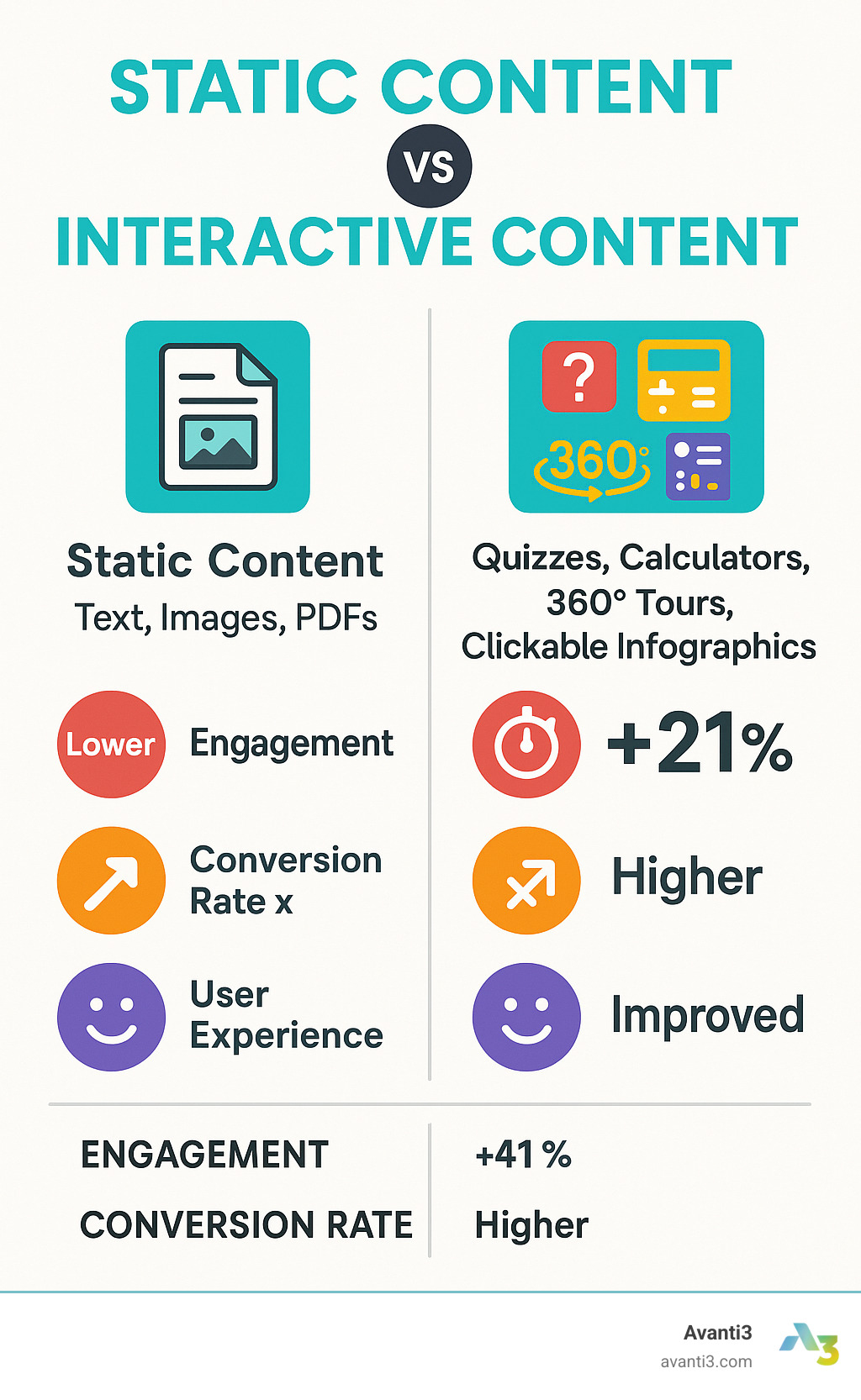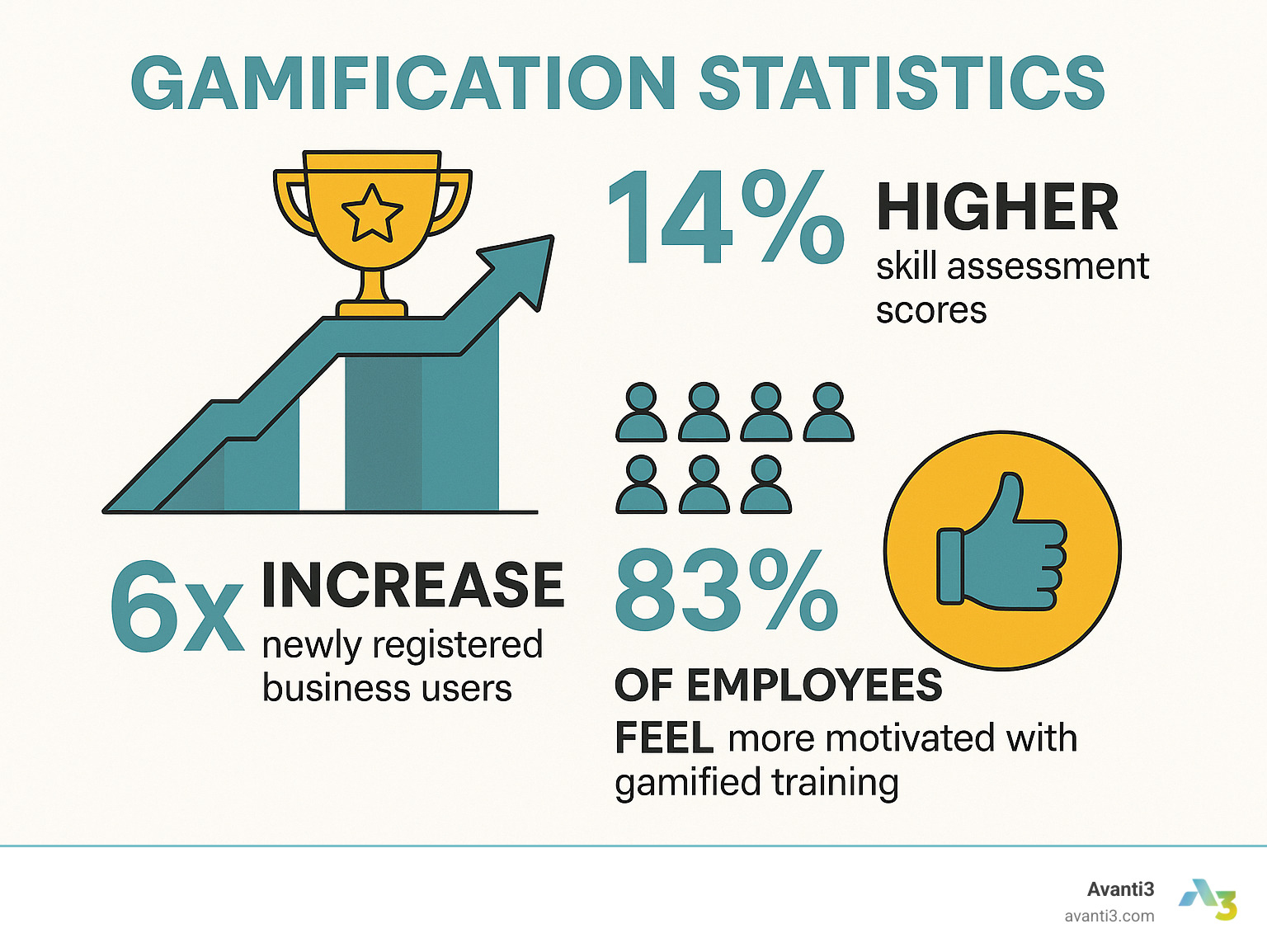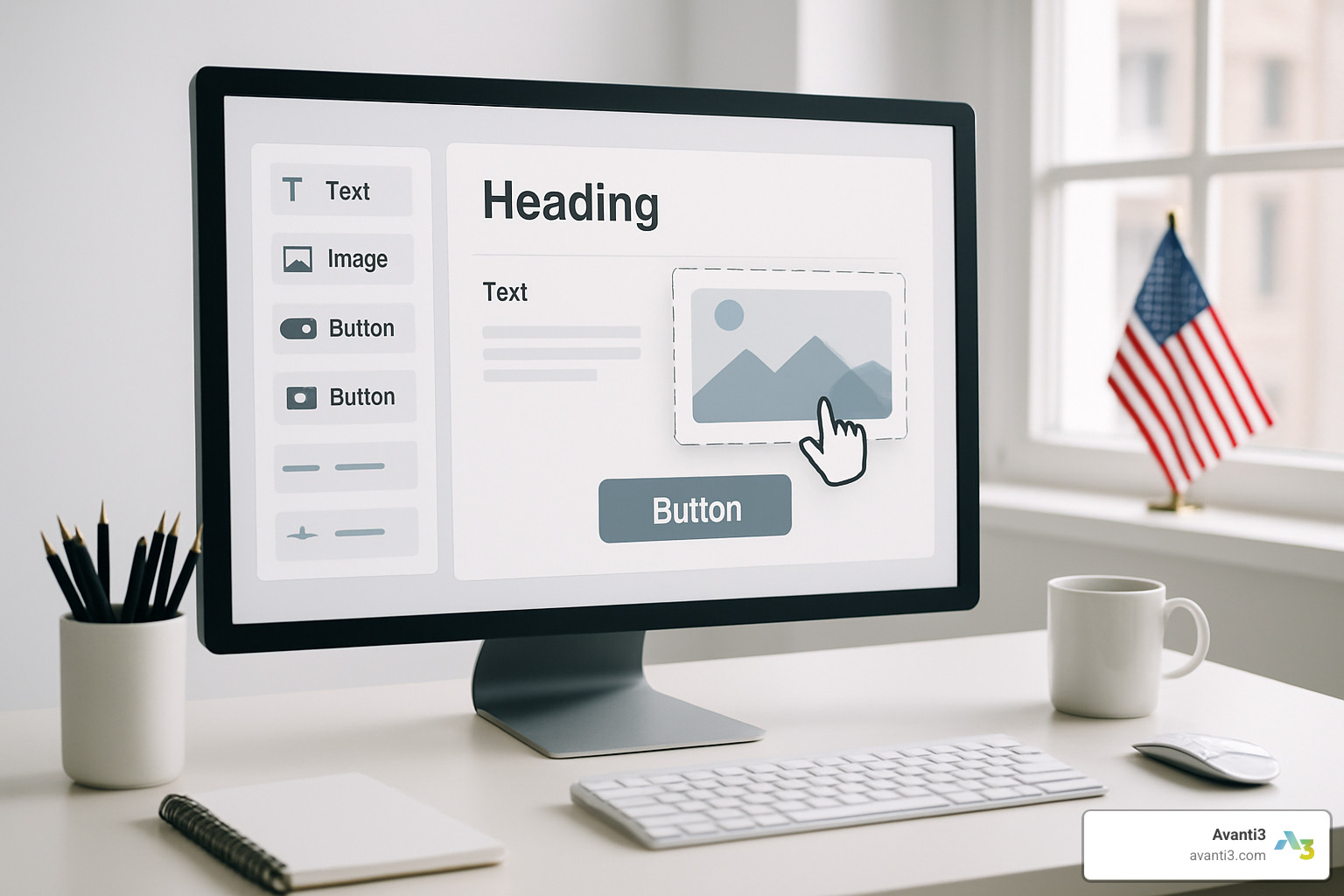Interactive Content Creation: Top 3 Powerful Ways for Success 2025
Why Interactive Content Creation Is Changing Digital Engagement
Interactive content creation is changing how we connect with audiences online. Instead of static text and images, interactive content invites users to click, explore, and participate actively in the experience.
Quick Answer for Interactive Content Creation:
– What it is: Content that responds to user actions (clicks, hovers, swipes)
– Key formats: Quizzes, calculators, 360° tours, interactive infographics, polls
– Tools needed: No-code platforms like H5P, Genially, ThingLink, or Ceros
– Main benefit: Drives 2× more conversions than static content
– Getting started: Choose a format, pick a tool, create with templates, publish and embed
The numbers tell a compelling story. Interactive content drives two times more conversions than static content, according to Demand Gen research. When users can interact directly with a presentation, they’re 41% more likely to reach the end and spend 21% more time engaging with the material.
This shift matters because attention spans keep shrinking. Static PDFs and basic images struggle to hold interest in our digital world. Interactive experiences turn passive viewers into active participants, creating deeper connections and better outcomes.
The technology has also become surprisingly accessible. Modern no-code platforms let anyone create interactive quizzes, clickable infographics, and immersive 360° tours without writing a single line of code. Over 30 million users across 190+ countries have already created interactive content, generating more than 4 billion views.
I’m Samir ElKamouny AV, and I’ve helped countless businesses transform their digital presence through innovative interactive content creation strategies. My experience scaling businesses and mastering marketing has shown me how interactive experiences can completely reshape audience engagement and drive measurable results.

Essential interactive content creation terms:
– VR content creation tools
– blockchain creator economy
– NFT marketplace platforms
The Power of Interactive Content Creation
When you ask someone to click, explore, and make choices in your content, everything changes. Interactive content creation doesn’t just boost engagement metrics – it fundamentally transforms how people connect with your message.
The science behind this is compelling. When we move from passive scrolling to active participation, our brains switch into a completely different mode. Interactive activities help people retain six times more information compared to just reading static content.
For businesses, this translates into something even more exciting: interactive content converts buyers approximately 70% of the time – nearly double the rate of traditional static content.
Engagement & Learning Benefits
The learning boost from interactive content creation happens because of “active learning.” Instead of sitting back and hoping information sinks in, users become participants in their own learning journey.
Quizzes represent one of the most powerful forms of this active engagement. They don’t just test what you know – they actually strengthen memory through the “testing effect.” Each time you retrieve information from memory to answer a question, you’re making that knowledge more durable.
The scientific research on learning retention backs this up with solid data. Active learning techniques, including interactive content, can improve retention rates by 300-600% compared to traditional passive methods.
Business & Marketing Impact
The business benefits of interactive content creation go way beyond just keeping people engaged longer. Interactive experiences become powerful lead generation tools because they offer genuine value while naturally collecting user information.
The buyer journey becomes much more personalized with interactive elements. Instead of showing everyone the same generic content, interactive experiences adapt based on each person’s responses. This personalization extends dwell time significantly and improves conversion rates.
Lead qualification becomes almost effortless. Traditional contact forms give you basic information, but interactive assessments can score prospects based on their responses.
Gamification Effect
Adding game-like elements to content taps into our love of achievement, competition, and progress. Leaderboards, points, badges, and progress bars transform routine interactions into engaging experiences that people actually want to complete.
Studies show that people using gamified content score 14% higher in skill-based assessments compared to traditional learning methods. Even simple virtual rewards like points and badges trigger psychological satisfaction.
Progress indicators provide crucial psychological feedback. A simple progress bar showing “3 of 5 questions completed” gives people a clear sense of advancement and motivation to continue.

Interactive Content Formats & Tools
The world of interactive content creation offers an exciting playground of possibilities. Quizzes are the friendly neighborhood heroes of interactive content. Calculators solve real problems while quietly collecting valuable insights about your users. 360° tours transport people anywhere without leaving their couch. Interactive infographics turn boring data dumps into explorable journeys.
Interactive videos add clickable magic to traditional footage. Maps with clickable hotspots work beautifully for location-based businesses. AR and VR experiences represent the frontier of interactive content creation, delivering ultimate immersion.
The beauty of modern platforms is their no-code approach. You don’t need a computer science degree to create engaging interactive experiences. Over 30 million creators worldwide have already finded this, generating billions of views with drag-and-drop simplicity.
| Static Content | Interactive Content |
|---|---|
| PDFs, basic images | Quizzes, calculators, 360° tours |
| One-way communication | Two-way engagement |
| Average 2-minute dwell time | 5-8 minute engagement |
| 15% conversion rate | 30% conversion rate |
| Limited data collection | Rich user insights |
| Fixed user journey | Personalized experience paths |
Content Type Spectrum
Interactive content exists on a spectrum from simple assessments to mind-blowing immersive VR experiences. Simple assessments like polls and basic quizzes require minimal technical lifting but still outperform static content significantly.
Branching scenarios get more sophisticated by adapting based on user choices. Drag-and-drop interfaces let users manipulate content directly. Immersive VR experiences sit at the complexity peak, demanding specialized equipment but delivering unforgettable experiences.
Tool Selection Guide for Interactive Content Creation
Choosing your interactive content creation platform feels overwhelming with so many options available. Drag-and-drop editors eliminate coding headaches entirely. Analytics dashboards reveal the story behind user interactions. Mobile-friendly design isn’t optional anymore – it’s essential.
Template libraries accelerate your creative process by providing professionally designed foundations. Integration capabilities matter when connecting with existing marketing tools.
For advanced capabilities that leverage artificial intelligence, explore AI Tools for Creators to improve your interactive content with intelligent features and automation.
Integrating Into Websites, Apps, LMS
Embed codes provide the simplest integration path. iFrame embedding offers more control over sizing and positioning. LTI (Learning Tools Interoperability) standards enable seamless connections with learning management systems. SCORM packages allow interactive content to communicate with learning management systems.
Responsive design ensures your interactive content works beautifully across all device types. For comprehensive integration strategies, explore Digital Engagement Platforms for centralized interactive content management solutions.

How to Create Interactive Content Step by Step
Creating effective interactive content requires a structured approach that balances user experience with your business objectives. The foundation lies in thorough planning – understanding your audience, defining clear objectives, and mapping out the user experience.
Storyboarding helps visualize the user journey through your interactive experience. Asset preparation streamlines the creation process. Iterative design allows for continuous improvement based on user feedback and testing.
Ideation & Storyboarding for Interactive Content Creation
Effective interactive content creation begins with understanding your users and their needs. User personas help guide design decisions by keeping real people at the center of your creative process.
Start by defining clear objectives for your interactive content. Map out the narrative flow of your interactive experience. Unlike linear content, interactive pieces branch based on user choices. Document these decision points to ensure logical progression.
Content chunking breaks complex information into digestible pieces. Interactive formats excel at revealing information progressively, preventing cognitive overload while maintaining engagement.
Design & Build Without Code
Modern interactive content creation platforms eliminate technical barriers through intuitive visual editors. Templates provide professional starting points that you can customize with your own content and branding.
Theme kits ensure visual consistency across all interactive elements. Accessibility checks help ensure your interactive content works for users with disabilities. Micro-interactions add polish and feedback to user actions.
Preview modes let you test your interactive content before publishing. Use these features to identify usability issues and ensure all interactive elements function correctly across different devices.
Launch, Measure & Iterate
Successful interactive content creation doesn’t end at launch. Key Performance Indicators (KPIs) should align with your original objectives. Heat maps reveal how users actually interact with your content.
xAPI (Experience API) provides detailed tracking of user interactions within your content. ROI calculations help justify continued investment in interactive content. Optimization loops create systematic improvement processes.
The scientific study on interactive infographics demonstrates how interactive elements can significantly improve information comprehension and retention compared to static alternatives.
Best Practices, Challenges & Reuse
Creating successful interactive content creation experiences goes beyond just building the content itself. The real magic happens when you master the fundamentals of user experience, accessibility, and strategic reuse.
UX simplicity should be your north star. Focus on clear navigation, intuitive interactions, and logical information architecture. Accessibility isn’t just about compliance – it’s about creating experiences that work for everyone.
Mobile-first design has become non-negotiable. Content chunking prevents overwhelming feelings users get when faced with too much information at once. Regular updating keeps your interactive content fresh and accurate.
Repurposing maximizes the value of your interactive content investment. A single interactive assessment can be adapted for different audiences, embedded in multiple locations, or updated with new information.
For businesses ready to push boundaries, explore AR/VR Immersive Experiences that can take user engagement to extraordinary new levels.
UX & Accessibility Tips
Color contrast ratios should meet WCAG guidelines to ensure text remains readable for users with visual impairments. Keyboard navigation support allows users who cannot use a mouse to access all interactive features.
Alt-text descriptions for interactive elements help screen readers convey functionality to visually impaired users. Cognitive load management prevents user overwhelm by limiting simultaneous choices and clearly indicating progress.
Error prevention and recovery help users correct mistakes without frustration. Provide clear feedback when interactions don’t work as expected.
Reuse, Share & Scale
Smart interactive content creation strategy involves thinking beyond individual pieces to build systems that multiply your investment. Template libraries allow you to create consistent interactive experiences while dramatically reducing development time.
Modular design enables mixing and matching interactive components for different purposes. Cross-channel distribution multiplies your content’s reach exponentially. Embed codes make sharing interactive content effortless.
Overcoming Common Challenges
Hosting requirements vary dramatically between platforms. Load speed optimization becomes critical as interactive content often includes multiple media files and complex functionality. Analytics setup can be more complex than static content tracking.
Maintenance requirements increase with interactive content complexity. Plan for regular updates, bug fixes, and compatibility testing. Skill gaps within your team might require training or external support.

Frequently Asked Questions about Interactive Content Creation
What is the difference between interactive and static content?
Static content is like a one-way conversation. You create a PDF, blog post, or infographic, and your audience consumes it passively. Interactive content creation flips this completely. Now your audience becomes an active participant. They click buttons, answer questions, drag elements around, or input their own information.
Here’s a simple example: A static infographic about home buying might show average mortgage rates. An interactive version lets users input their income, down payment, and location to calculate their specific monthly payment.
The results speak for themselves. Users spend 21% more time engaging with interactive content and are 41% more likely to complete the entire experience.
Do I need coding skills to start interactive content creation?
You absolutely do not need any coding skills to create professional interactive content. Modern platforms have made this incredibly accessible through drag-and-drop editors that work just like creating a PowerPoint presentation.
The platforms handle all the technical heavy lifting behind the scenes. They provide hosting, manage databases, ensure mobile compatibility, and generate analytics reports. You focus on creating great content while they handle the technical infrastructure.
Most platforms offer thousands of templates covering every use case you can imagine. If you can create a decent PowerPoint presentation, you can create interactive content.
How do I measure the success of interactive content?
Measuring success with interactive content creation requires looking at different metrics than traditional content. Start with engagement metrics like completion rates and time spent. Interactive content should keep people engaged longer than static alternatives.
Conversion metrics matter most for business results. Track how many people take your desired action after engaging with interactive content. Interactive content typically drives twice the conversion rates of static content.
For educational content, measure learning outcomes through assessment scores. Calculate your cost per lead, customer acquisition cost, and overall return on investment. Interactive content often requires more upfront investment but delivers significantly better long-term results.
Conclusion
The world of digital engagement is changing fast, and interactive content creation is leading the charge. Interactive content drives 2× more conversions than static alternatives, helps users retain 6× more information, and keeps them engaged 21% longer.
What excites me most is how accessible this technology has become. With over 30 million users already building interactive content across 190+ countries, there’s a thriving community and robust tools ready to support your journey.
The future looks even brighter. AI is making content creation smarter and more personalized. AR and VR are creating experiences we could only dream about a few years ago. Early adopters of these technologies will have a massive advantage as they become mainstream.
This is where Avanti3 comes in. By integrating Web3 technologies like NFTs, blockchain, AR/VR, and AI, we empower creators and brands with customizable engagement tools that set new standards in digital interaction and fan monetization.
Your interactive content creation journey can start today. Pick something simple like a quiz or calculator. Choose a user-friendly platform. Create your first interactive piece and watch how differently your audience responds.
The shift toward interactive, personalized, and immersive content isn’t coming – it’s already here. The question is whether you’ll be a pioneer or play catch-up later.
Ready to take the leap? Explore our comprehensive Digital Experience Design solutions and find how Avanti3 can lift your interactive content strategy.
The future belongs to creators who understand that great content isn’t just consumed – it’s experienced. Start building those experiences today.







